Putting together webinars is one of our favourite tasks. It’s an opportunity for Energy-Storage.news to work with some of the leading companies in the industry to shed light on topics of importance to our readers.
Over the past three years or so, that’s included numerous sessions covering strategies for managing and operating battery storage systems, ultracapacitors, emerging or maturing markets in Israel, Greece and India, tracking battery cost curves, readying the electricity grid for net zero and much, much more.
This year so far, our four excellent webinars have focused on how to manage the market participation of utility-scale battery energy storage system (BESS) assets, things you should know about UL9540A codes and standards for energy storage system safety, and two very different looks at the role of battery analytics.
Managing utility-scale batteries in the energy transition
2 March 2023
Our webinar with optimisation and trading specialist GridBeyond looked at managing utility-scale battery storage assets and their role in the energy transition, in leading markets including ERCOT in Texas, the UK, and Ireland.
In this webinar, experts from GridBeyond explore:
The role of batteries in the energy sector’s transition to net zero
Commercial perspectives around operating and optimising battery storage assets
Key considerations for securing financing for assets
The importance of market forecasting, revenue stacking, dispatch optimisation, and auction strategies in ensuring that battery storage assets achieve their full value potential
[embedded content]
Register to view on-demand and received presentation slides as well as access to the full recording here.
What experts think you should know about UL9540 codes and standards for battery storage
9 March 2023
Our webinar with global system integrator IHI Terrasun looked at the evolution of standards for the testing and certification of BESS technology. The presentation features experts in the field who perform testing and certification work at different stages, including in the design of technical standards for testing and in the lab to verify testing.
The webinar covers:
The latest changes to the UL9540 Codes and Standards and how those changes apply to large-scale and distributed generation energy storage projects in the design phase, in testing and for field certification.
How to safeguard battery energy storage systems to ensure they meet the requirements for fire and explosion protection.
An overview of UL9540A testing.
A discussion on how test results are utilised.
Common issues related to the design of energy storage safety systems.
[embedded content]
Register to view on-demand and received presentation slides as well as access to the full recording here.
De-risk and protect your battery storage asset from the very start with Digital Commissioning and In-Life Analytics
30 May 2023
In this webinar with cloud-based battery analytics specialist TWAICE, we look at the role of cloud-based battery analytics in ensuring battery storage assets get the right commissioning and in-life management.
This webinar is tailored for asset owners, operators, and individuals interested in BESS deployment and operations.
Featuring short presentations from TWAICE followed by a 15 minute Q&A session, the webinar explores:
How Digital Commissioning can help asset owners ensure maximum availability of their BESS during the critical initial years of operation, laying the groundwork for a successful, reliable and profitable business.
The benefits of in-life analytics, which enable continuous monitoring and optimisation of BESS performance throughout an asset’s entire lifetime.
[embedded content]
Register to view on-demand and received presentation slides as well as access to the full recording here.
The economic benefits of cloud-based battery analytics for energy storage assets
8 June 2023
Energy-Storage.news partnered with analytics provider PowerUp for this look at the economic benefits cloud-based battery analytics can deliver for battery energy storage systems. In today’s dynamic energy landscape, optimising the performance of battery assets is crucial to ensure the competitiveness and financial success of assets’ operators. These challenges include successfully optimising asset performance, minimising costs, and ensuring the safety of the system.
To overcome these challenges, battery storage operators must stay ahead of the curve and implement innovative technologies.
In this webinar PowerUp expert speakers showcase real-world examples of how this innovative technology can boost your bottom line and provide a competitive edge in today’s dynamic energy market.
[embedded content]
Register to view on-demand and received presentation slides as well as access to the full recording here.
Continue reading










